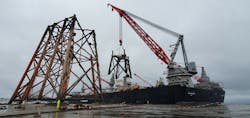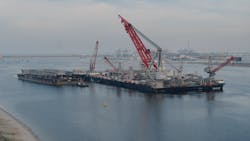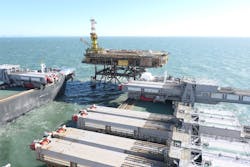Over the past 15 months, Pioneering Spirit has added lighter jacket removals and offshore wind platform installations to its track record, both delivered via a new purpose-built, 5,000-metric ton (5,511-ton) crane. Now Allseas is close to realizing its vision of a construction/decommissioning vessel for all offshore occasions with a unique lifting system for mid to large-size jackets about to be tested in Rotterdam Harbor, following installation on the vessel’s stern. The first commercial deployment should be the removal next spring of the 8,500-metric ton (8,818-ton) Ninian Northern jacket in the UK northern North Sea for operator Canadian Natural Resources.
Preparations for both new lifting systems were already under way when Pioneering Spirit started operating in 2016, going on to perform record-breaking topsides lifts at the Brent and Johan Sverdrup field complexes in the North Sea. The 5,000-t fixed slewing crane, which can also handle placement/removal of subsea structures, smaller topside modules, flares and bridges, was designed by Huisman and constructed in China and Schiedam, the Netherlands, with Allseas supplying specifications for the outreach capacity and boom length. The capacity main hoist is 5,000 t at 35 m (115 ft) outreach; the auxiliary hoist is 800 t at 95 m (312 ft) outreach; and the whip hoist is 100 t at 129 m (423 ft) outreach. The completed system underwent performance tests and final commissioning in March 2020 in Rotterdam’s Alexiahaven harbor.
Its first major campaign was TotalEnergies’ Tyra field redevelopment project in the Danish North Sea. During two weeks in August 2020, the vessel removed over 27,000 metric tons (29,762 tons) of platform structures in a sequence of lifts: this started with the 14,000-metric ton (15,432-ton) processing platform (TEA) topsides and the 7,800-metric ton (8,598-ton) TWA accommodation platform topsides, both removed using the vessel’s motion-compensated topsides lift system and subsequently delivered in separate trips to the M.A.R.S. recycling center in Frederikshavn, Denmark. The vessel then returned to lift the two flare jackets using the new 5,000-t crane, both of which were hoisted onto the deck for subsequent transfer to a cargo barge, and onward to the Sagro yard in Vlissingen, the Netherlands.
Tyra’s redevelopment is necessary due to 6 m (19.7 ft) of seabed subsidence that has set in around the facilities since production started in 1984. Although structural integrity was not an issue for this campaign, the level of subsidence “means that the points where you pick up the jackets are very near to the splash zone,” said Allseas President Edward Heerema, “and that limits workability for the preparations. For both jackets, we had to make cuts close to the seafloor, performed by suppliers of a diamond wire cutting system and an abrasive water jetting system that operates at the mudline.” The DP construction support vessel Fortitude, which the company acquired in 2018, ran the operation with the subcontractors.
The next jacket lift took place in June and July this year at the Aker BP-operated Valhall field complex in the southern Norwegian North Sea, another development that has been impacted by subsidence. Here the water depth is greater than Tyra’s, at 70 m (229 ft), and removal of the 3,300-metric ton (2,756-ton) QP accommodation platform jacket, which entered service in 1982, had to be undertaken in two separate operations. “In this case,” Heerema explained, “the crane’s reach height required us to make an initial cut halfway down the structure. The jacket was in excellent condition, but the client had suspicions over the integrity of some of the bracings, and we were asked to inspect these as part of our preparations for attaching slings.”
Pioneering Spirit first crane-lifted the 800-metric ton (882-ton) upper section of the jacket, followed a few days later by the 2,500-t lower section. The removal process was not time-critical, Heerema said, unlike the heavy topsides lifts which following lift-off have to be executed quickly while the vessel is moving up and down to avoid re-impact of the topsides on the base structure. “With the jackets, and the elasticity of the slings, you don’t need to lift within seconds as the operation involves stretching an enormous length of cable over a longer period of time, with no impact on the jacket’s cut-off points. What was novel in this case was lifting of the lower part of the structure, which did not protrude above the water and therefore required different fastenings. We had to create ‘windows’ in the legs of the jackets in order to provide lifting points for the hooks.”
In this case, Allseas’ Heavy Lift Engineering Department designed the lifting tools and procedures, with Machinefabriek Schaap machining and assembling the hooks from high-grade steel left over from the beams of the new jacket lifting system. Allseas Fabrication provided the spreader bars and integration of the hooks (which will be re-used for future projects) with the lifting/operating frames and the hydraulics. A team onboard the DSV Oceanic made the cuts to the jacket legs and the holes for the hooks, with the vessel also providing ROV support. Oceanic, a newbuild when Allseas acquired it in 2017, has also been deployed to make cuts or strengthen structures for topsides removals, performing these tasks much quicker than would be possible from Pioneering Spirit. The QP jacket was removed under Allseas’ framework contract with Aker BP, and the company will return to Valhall over the next five years for further topsides/jacket removals and installations during windows that suit both parties.
Early last month, the two 170-m (558-ft) long, S690-grade steel beams for Pioneering Spirit’s new Jacket Lift System (JLS) arrived in Rotterdam following a week-long tow from the Cimolai construction yard in Monfalcone, northern Italy. The two beams, each weighing 6,000 metric tons (6,614 tons), will be able to support removal and installation in a single lift of jackets weighing up to 20,000 metric tons (22,046 tons). Originally, Allseas had hoped to have the JLS up and running by late 2019, but various developments combined to scupper that plan. These included a sudden deterioration in the offshore market which forced the company to cut costs, leading to the decision to extend the period for building and commissioning the JLS to 2022, when it would start to be needed. COVID-19 also delayed fabrication of the main beams. “We used the extra time to design the structure better,” Heerema said, “ensuring it would be ready for the first project commitments in 2022. Having more time also allows you to sort out details of the control systems better - commissioning of these is always a bottleneck.”
The assembly of the JLS, which will be installed permanently between the vessel’s bows, involved slowly skidding the two beams over the aft deck to their final resting place, followed by alignment (less than 2 mm separation) and connection with the Hang-off Frame and Upend System (HOUS). The beams’ integrated tail extensions will be used to lift and support jackets during transport and installation/removal operations.
The function of the HOUS is to raise and tilt the 170-m lifting beams. Its upend systems are each equipped with two 50-m (164-ft) skid tracks with push-pull devices: hydraulic cylinders drive these devices along the tracks, moving the beams upwards, while at the same time transom-mounted hang-off frame assemblies serve as hinges around which the beams rotate. For jacket removals, after the piles have been cut close to the seafloor, hoisting blocks are lowered from the beams and connected to hooks on the top of the jacket. Next, grommets are lifted and secured on the main hoist trunnion hooks. The jacket is then pulled out of the water by the main hoist system, with the beams raised by the upend system and ballast water. Following alignment with the beams, the jacket is tilted toward the deck. Finally, it is lifted over the vessels’ stern and secured on the aft deck, still reclining on the beams, for transit. For jacket installations, the operation is reversed.
“The skids are always different, they have to be fitted exactly to support each individual jacket at the right width and to take the downward loads. However, there is no need to seafasten the jacket to the beams during transit due to the high level of stability of the vessel. The JLS is also equipped with very accurate weight monitoring gauges, which ensure that the weight is distributed correctly. If a removed jacket had to make an Atlantic crossing during the fall, that’s one instance where we might add more fixations on the beams.”
Trials with the JLS are due to take place in Rotterdam next spring. “We will have to have Iron Lady ballasted with water to be sufficiently heavy to test the JLS at 20,000 t, fully laden. These tests may not be as thrilling as Pioneering Spirit’s topsides lift trials in 2016, but they will still be very interesting for clients such as CNR, Repsol and TotalEnergies to observe. As for maneuvering of the vessel, the DP system was designed for very accurate positioning of the central U-shaped area around the topside, to within centimeters. That level of precision is not as critical for jackets. However, each jacket lift is different in terms of weight, dimensions, width, and water depth. Each one requires a lot of engineering, although the philosophy behind the JLS is for the system to lift any size of jacket, heavy or small, whether in deep or shallow water. Operable weather conditions are the same as for heavy topsides lifts: in rougher seas, topsides lifts are more critical in terms of motions, although in these cases we use active heave compensation. With jacket lifts, there is much more freedom in terms of the ship’s motions.
“The reason for locating the JLS at the aft deck of the vessel is to provide sufficient space for the jacket lifts. The JLS is a permanent piece of equipment on the ship, but it can also be moved sideways to accommodate narrower or wider jacket lifts. Before executing any lifts, we would first need to remove one component of the pipelay equipment, the removable bevelling station, which is also stationed on the aft side.”
This spring, Pioneering Spirit conducted its first single-lift removals outside the North Sea, the topsides for Spirit Energy’s Morecambe Bay DP3 and DP4 gas platforms in the East Irish Sea off northwest England. The shallow waters in this area are subject to wide-ranging currents due to the tidal conditions. In this case, through ballasting Pioneering Spirit, the DP4 topsides removal was not a tidal restricted operation. For DP3, a tidal restricted operation was planned, and a weather and time window determined. In the event, safe execution of the lifts was completed within hours of the vessel’s arrival at the field location. While the North Sea and North Atlantic offer some of the world’s most aggressive conditions, Allseas also envisages the vessel being tested in future in other offshore regions that present different conditions, notably Eastern Canada, California (high wave swells), West Africa (very long swells), and southeast Australia.
Another innovation the company can now offer is the use of in-house developed ‘horseshoes’ connection tools which are positioned around pre-installed lift points mounted on the upper sections of the jacket’s legs. The system was first proven in summer 2020 for the single-lift removal of the 17,000-metric ton (18,739-ton) Brent Alpha topsides for Shell UK, a structure measuring 94 m high and 52 m wide (308 x 171 ft). “Horseshoes give you possibilities, depending on the nature of the topsides, to do the least preparation works,” Heerema explained. “Essentially, it’s a sort of locking system, whereby the horseshoes clamp into bearing brackets mounted on the legs of the topsides. It’s also a way to avoid having to do strengthening of the yokes, as is the case with certain topsides.”
As for future improvements, the capacity of the vessel’s topsides lift system is being raised from the current 48,000-metric ton (52,911-ton) to 60,000 metric tons (66,139 tons). This will be needed when the time comes for Equinor to finally shut down the Statfjord A platform in the Norwegian North Sea, which was originally built for Mobil in the 1970s. Allseas was awarded the topsides removal contract, but the program was subsequently pushed back when Equinor and its partners decided it might be economic to extend production from the Statfjord field through further development. The topsides will probably not be removed now before 2025, or possibly later. One issue, Heerema said, is that no one knows how heavy the structure is.
The Statfjord A, B and C platforms are Condeep designs supported by three concrete columns with cells for oil storage. How to remove these and other platform concrete substructures at fields such as Brent and eventually Troll is another poser. “These are very big structures, 85-100 m [279-328 ft) wide. One idea is to remove the columns to the level of the concrete base using the jacket lift system.”
Finally, the company has now joined the offshore renewable energy legion, following Pioneering Spirit’s recent installation of the HV converter platform for the Saint-Nazaire wind farm in the Bay of Biscay off western France. Over two days in August the vessel’s 5,000-t crane installed the 50-m (164-ft) tall, 1,250-metric ton (1,377-ton) jacket, followed by the 2,100-metric ton (2,315-ton), 480-MW electrical substation, both having been brought to the offshore location on a cargo barge. The shallow-water setting meant the vessel had to operate at small draft. Due to the rocky seabed, the project’s main contractor DEME Offshore had to drill through holes in the jacket’s steel base foundation to accommodate the piles. The completed platform will convert power generated by 80 turbines for export to the mainland. Similar jobs are set to follow, with Allseas securing work for several convertor platforms, ranging in size and weight, for wind farm projects in the North Sea.
The company also sees a future role for Pioneering Spirit in the installation of next generation, heavier and larger turbines and monopiles.
About the Author
Jeremy Beckman
Editor, Europe
Jeremy Beckman has been Editor Europe, Offshore since 1992. Prior to joining Offshore he was a freelance journalist for eight years, working for a variety of electronics, computing and scientific journals in the UK. He regularly writes news columns on trends and events both in the NW Europe offshore region and globally. He also writes features on developments and technology in exploration and production.




